NURBN3022: Ethics Application - Needle Stick Injuries in Healthcare
VerifiedAdded on 2023/06/04
|7
|3248
|300
Practical Assignment
AI Summary
This document provides a sample application for Human Research Ethics Committee (HREC) approval, focusing on a research project investigating needle stick injuries in healthcare settings. The project aims to explore the effectiveness of current training procedures and needle safety devices in preventing these injuries. The application includes details on the project's aims, significance, research methodology (including data collection and analysis techniques), recruitment of participants, and risk management strategies. The research intends to gather data from healthcare workers, students, and patients through surveys, interviews, and literature reviews, adhering to ethical considerations such as data protection and participant privacy. This sample application serves as a guide for students learning to prepare ethics applications for research projects. Desklib provides a platform for students to access this and other helpful study resources.
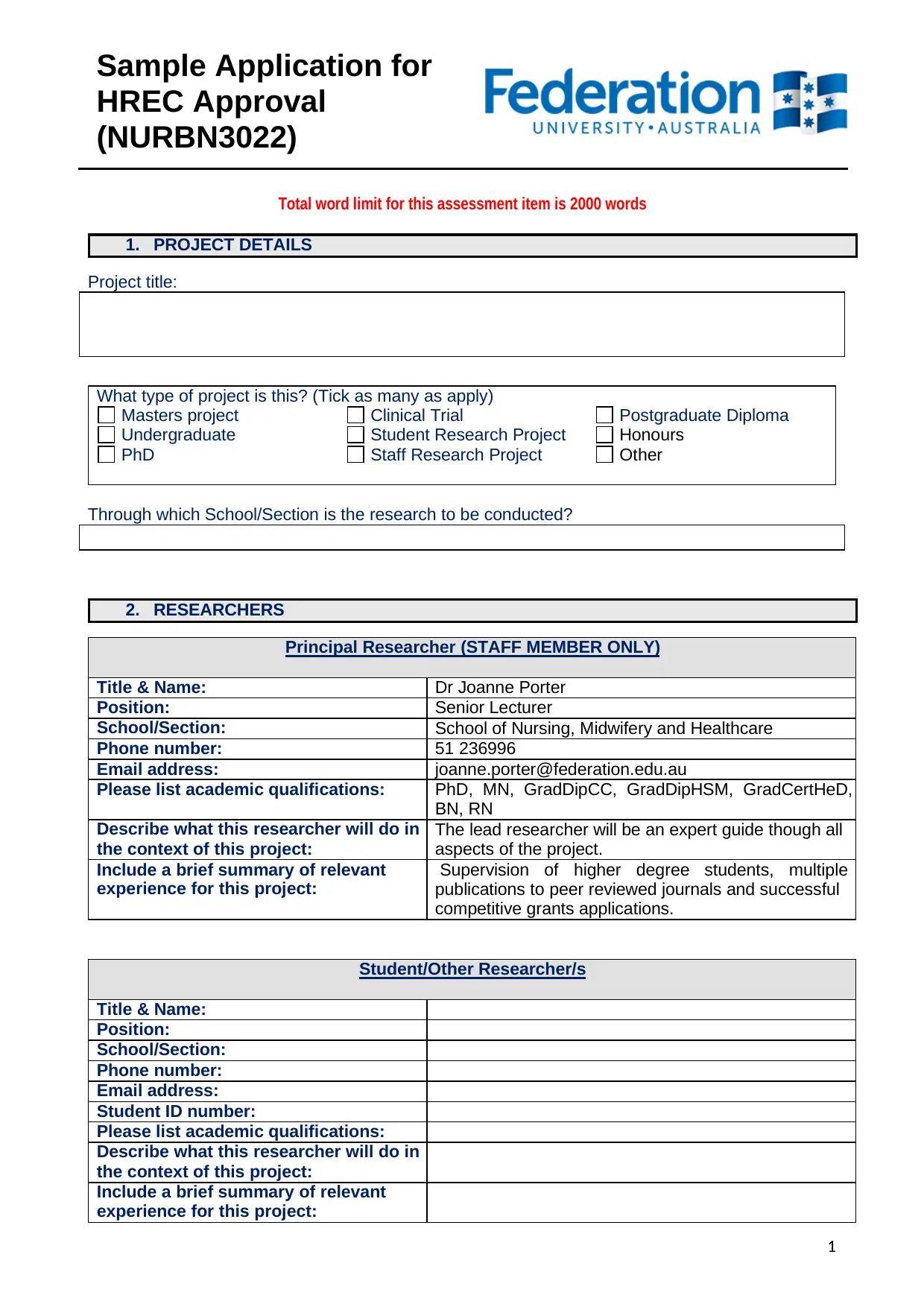
Sample Application for
HREC Approval
(NURBN3022)
Total word limit for this assessment item is 2000 words
1. PROJECT DETAILS
Project title:
What type of project is this? (Tick as many as apply)
Masters project Clinical Trial Postgraduate Diploma
Undergraduate Student Research Project Honours
PhD Staff Research Project Other
Through which School/Section is the research to be conducted?
2. RESEARCHERS
Principal Researcher (STAFF MEMBER ONLY)
Title & Name: Dr Joanne Porter
Position: Senior Lecturer
School/Section: School of Nursing, Midwifery and Healthcare
Phone number: 51 236996
Email address: joanne.porter@federation.edu.au
Please list academic qualifications: PhD, MN, GradDipCC, GradDipHSM, GradCertHeD,
BN, RN
Describe what this researcher will do in
the context of this project:
The lead researcher will be an expert guide though all
aspects of the project.
Include a brief summary of relevant
experience for this project:
Supervision of higher degree students, multiple
publications to peer reviewed journals and successful
competitive grants applications.
Student/Other Researcher/s
Title & Name:
Position:
School/Section:
Phone number:
Email address:
Student ID number:
Please list academic qualifications:
Describe what this researcher will do in
the context of this project:
Include a brief summary of relevant
experience for this project:
1
HREC Approval
(NURBN3022)
Total word limit for this assessment item is 2000 words
1. PROJECT DETAILS
Project title:
What type of project is this? (Tick as many as apply)
Masters project Clinical Trial Postgraduate Diploma
Undergraduate Student Research Project Honours
PhD Staff Research Project Other
Through which School/Section is the research to be conducted?
2. RESEARCHERS
Principal Researcher (STAFF MEMBER ONLY)
Title & Name: Dr Joanne Porter
Position: Senior Lecturer
School/Section: School of Nursing, Midwifery and Healthcare
Phone number: 51 236996
Email address: joanne.porter@federation.edu.au
Please list academic qualifications: PhD, MN, GradDipCC, GradDipHSM, GradCertHeD,
BN, RN
Describe what this researcher will do in
the context of this project:
The lead researcher will be an expert guide though all
aspects of the project.
Include a brief summary of relevant
experience for this project:
Supervision of higher degree students, multiple
publications to peer reviewed journals and successful
competitive grants applications.
Student/Other Researcher/s
Title & Name:
Position:
School/Section:
Phone number:
Email address:
Student ID number:
Please list academic qualifications:
Describe what this researcher will do in
the context of this project:
Include a brief summary of relevant
experience for this project:
1
Paraphrase This Document
Need a fresh take? Get an instant paraphrase of this document with our AI Paraphraser
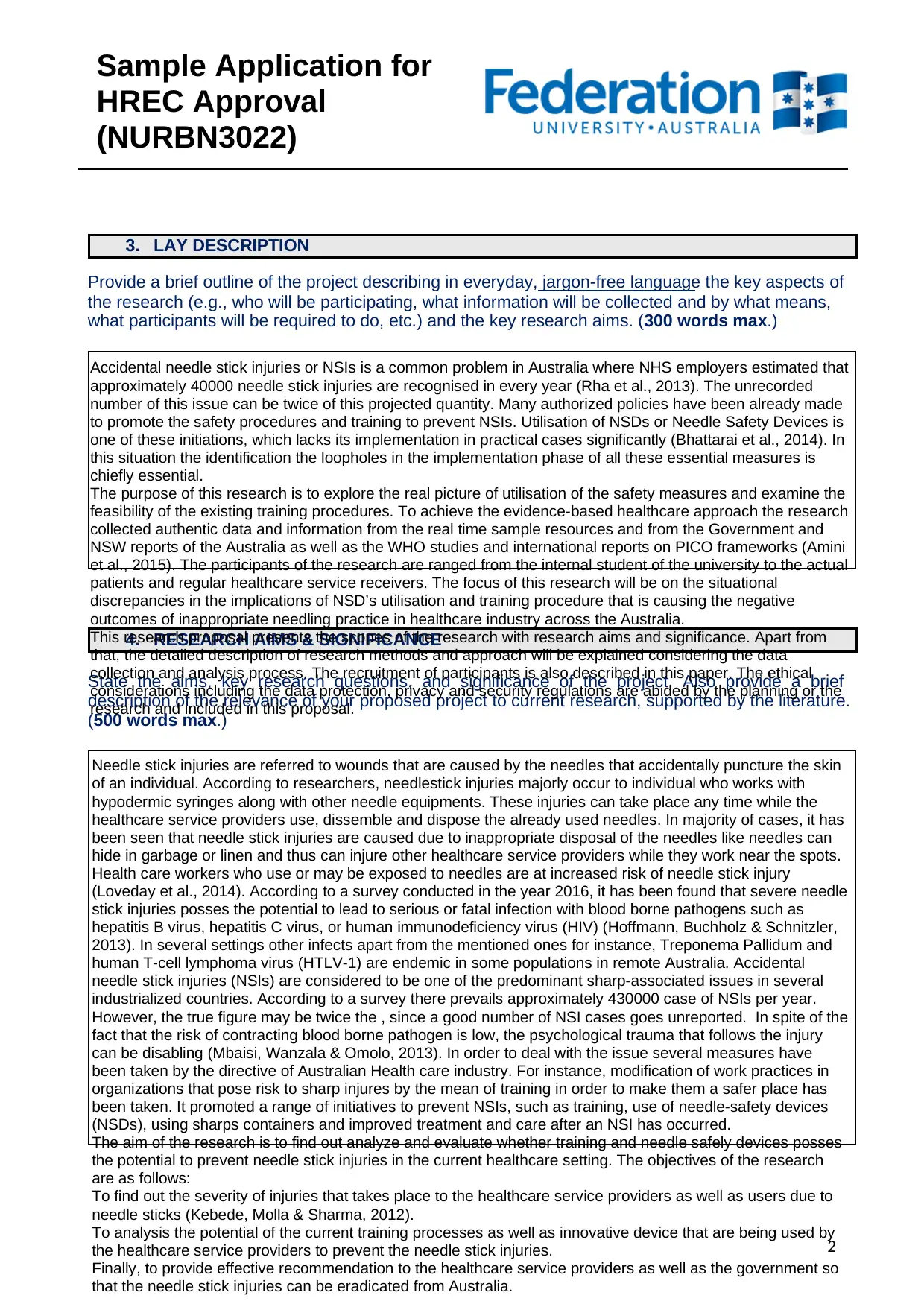
Sample Application for
HREC Approval
(NURBN3022)
3. LAY DESCRIPTION
Provide a brief outline of the project describing in everyday, jargon-free language the key aspects of
the research (e.g., who will be participating, what information will be collected and by what means,
what participants will be required to do, etc.) and the key research aims. (300 words max.)
4. RESEARCH AIMS & SIGNIFICANCE
State the aims, key research questions, and significance of the project. Also provide a brief
description of the relevance of your proposed project to current research, supported by the literature.
(500 words max.)
2
Accidental needle stick injuries or NSIs is a common problem in Australia where NHS employers estimated that
approximately 40000 needle stick injuries are recognised in every year (Rha et al., 2013). The unrecorded
number of this issue can be twice of this projected quantity. Many authorized policies have been already made
to promote the safety procedures and training to prevent NSIs. Utilisation of NSDs or Needle Safety Devices is
one of these initiations, which lacks its implementation in practical cases significantly (Bhattarai et al., 2014). In
this situation the identification the loopholes in the implementation phase of all these essential measures is
chiefly essential.
The purpose of this research is to explore the real picture of utilisation of the safety measures and examine the
feasibility of the existing training procedures. To achieve the evidence-based healthcare approach the research
collected authentic data and information from the real time sample resources and from the Government and
NSW reports of the Australia as well as the WHO studies and international reports on PICO frameworks (Amini
et al., 2015). The participants of the research are ranged from the internal student of the university to the actual
patients and regular healthcare service receivers. The focus of this research will be on the situational
discrepancies in the implications of NSD’s utilisation and training procedure that is causing the negative
outcomes of inappropriate needling practice in healthcare industry across the Australia.
This research proposal presents the scopes of the research with research aims and significance. Apart from
that, the detailed description of research methods and approach will be explained considering the data
collection and analysis process. The recruitment of participants is also described in this paper. The ethical
considerations including the data protection, privacy and security regulations are abided by the planning or the
research and included in this proposal.
Needle stick injuries are referred to wounds that are caused by the needles that accidentally puncture the skin
of an individual. According to researchers, needlestick injuries majorly occur to individual who works with
hypodermic syringes along with other needle equipments. These injuries can take place any time while the
healthcare service providers use, dissemble and dispose the already used needles. In majority of cases, it has
been seen that needle stick injuries are caused due to inappropriate disposal of the needles like needles can
hide in garbage or linen and thus can injure other healthcare service providers while they work near the spots.
Health care workers who use or may be exposed to needles are at increased risk of needle stick injury
(Loveday et al., 2014). According to a survey conducted in the year 2016, it has been found that severe needle
stick injuries posses the potential to lead to serious or fatal infection with blood borne pathogens such as
hepatitis B virus, hepatitis C virus, or human immunodeficiency virus (HIV) (Hoffmann, Buchholz & Schnitzler,
2013). In several settings other infects apart from the mentioned ones for instance, Treponema Pallidum and
human T-cell lymphoma virus (HTLV-1) are endemic in some populations in remote Australia. Accidental
needle stick injuries (NSIs) are considered to be one of the predominant sharp-associated issues in several
industrialized countries. According to a survey there prevails approximately 430000 case of NSIs per year.
However, the true figure may be twice the , since a good number of NSI cases goes unreported. In spite of the
fact that the risk of contracting blood borne pathogen is low, the psychological trauma that follows the injury
can be disabling (Mbaisi, Wanzala & Omolo, 2013). In order to deal with the issue several measures have
been taken by the directive of Australian Health care industry. For instance, modification of work practices in
organizations that pose risk to sharp injures by the mean of training in order to make them a safer place has
been taken. It promoted a range of initiatives to prevent NSIs, such as training, use of needle-safety devices
(NSDs), using sharps containers and improved treatment and care after an NSI has occurred.
The aim of the research is to find out analyze and evaluate whether training and needle safely devices posses
the potential to prevent needle stick injuries in the current healthcare setting. The objectives of the research
are as follows:
To find out the severity of injuries that takes place to the healthcare service providers as well as users due to
needle sticks (Kebede, Molla & Sharma, 2012).
To analysis the potential of the current training processes as well as innovative device that are being used by
the healthcare service providers to prevent the needle stick injuries.
Finally, to provide effective recommendation to the healthcare service providers as well as the government so
that the needle stick injuries can be eradicated from Australia.
HREC Approval
(NURBN3022)
3. LAY DESCRIPTION
Provide a brief outline of the project describing in everyday, jargon-free language the key aspects of
the research (e.g., who will be participating, what information will be collected and by what means,
what participants will be required to do, etc.) and the key research aims. (300 words max.)
4. RESEARCH AIMS & SIGNIFICANCE
State the aims, key research questions, and significance of the project. Also provide a brief
description of the relevance of your proposed project to current research, supported by the literature.
(500 words max.)
2
Accidental needle stick injuries or NSIs is a common problem in Australia where NHS employers estimated that
approximately 40000 needle stick injuries are recognised in every year (Rha et al., 2013). The unrecorded
number of this issue can be twice of this projected quantity. Many authorized policies have been already made
to promote the safety procedures and training to prevent NSIs. Utilisation of NSDs or Needle Safety Devices is
one of these initiations, which lacks its implementation in practical cases significantly (Bhattarai et al., 2014). In
this situation the identification the loopholes in the implementation phase of all these essential measures is
chiefly essential.
The purpose of this research is to explore the real picture of utilisation of the safety measures and examine the
feasibility of the existing training procedures. To achieve the evidence-based healthcare approach the research
collected authentic data and information from the real time sample resources and from the Government and
NSW reports of the Australia as well as the WHO studies and international reports on PICO frameworks (Amini
et al., 2015). The participants of the research are ranged from the internal student of the university to the actual
patients and regular healthcare service receivers. The focus of this research will be on the situational
discrepancies in the implications of NSD’s utilisation and training procedure that is causing the negative
outcomes of inappropriate needling practice in healthcare industry across the Australia.
This research proposal presents the scopes of the research with research aims and significance. Apart from
that, the detailed description of research methods and approach will be explained considering the data
collection and analysis process. The recruitment of participants is also described in this paper. The ethical
considerations including the data protection, privacy and security regulations are abided by the planning or the
research and included in this proposal.
Needle stick injuries are referred to wounds that are caused by the needles that accidentally puncture the skin
of an individual. According to researchers, needlestick injuries majorly occur to individual who works with
hypodermic syringes along with other needle equipments. These injuries can take place any time while the
healthcare service providers use, dissemble and dispose the already used needles. In majority of cases, it has
been seen that needle stick injuries are caused due to inappropriate disposal of the needles like needles can
hide in garbage or linen and thus can injure other healthcare service providers while they work near the spots.
Health care workers who use or may be exposed to needles are at increased risk of needle stick injury
(Loveday et al., 2014). According to a survey conducted in the year 2016, it has been found that severe needle
stick injuries posses the potential to lead to serious or fatal infection with blood borne pathogens such as
hepatitis B virus, hepatitis C virus, or human immunodeficiency virus (HIV) (Hoffmann, Buchholz & Schnitzler,
2013). In several settings other infects apart from the mentioned ones for instance, Treponema Pallidum and
human T-cell lymphoma virus (HTLV-1) are endemic in some populations in remote Australia. Accidental
needle stick injuries (NSIs) are considered to be one of the predominant sharp-associated issues in several
industrialized countries. According to a survey there prevails approximately 430000 case of NSIs per year.
However, the true figure may be twice the , since a good number of NSI cases goes unreported. In spite of the
fact that the risk of contracting blood borne pathogen is low, the psychological trauma that follows the injury
can be disabling (Mbaisi, Wanzala & Omolo, 2013). In order to deal with the issue several measures have
been taken by the directive of Australian Health care industry. For instance, modification of work practices in
organizations that pose risk to sharp injures by the mean of training in order to make them a safer place has
been taken. It promoted a range of initiatives to prevent NSIs, such as training, use of needle-safety devices
(NSDs), using sharps containers and improved treatment and care after an NSI has occurred.
The aim of the research is to find out analyze and evaluate whether training and needle safely devices posses
the potential to prevent needle stick injuries in the current healthcare setting. The objectives of the research
are as follows:
To find out the severity of injuries that takes place to the healthcare service providers as well as users due to
needle sticks (Kebede, Molla & Sharma, 2012).
To analysis the potential of the current training processes as well as innovative device that are being used by
the healthcare service providers to prevent the needle stick injuries.
Finally, to provide effective recommendation to the healthcare service providers as well as the government so
that the needle stick injuries can be eradicated from Australia.
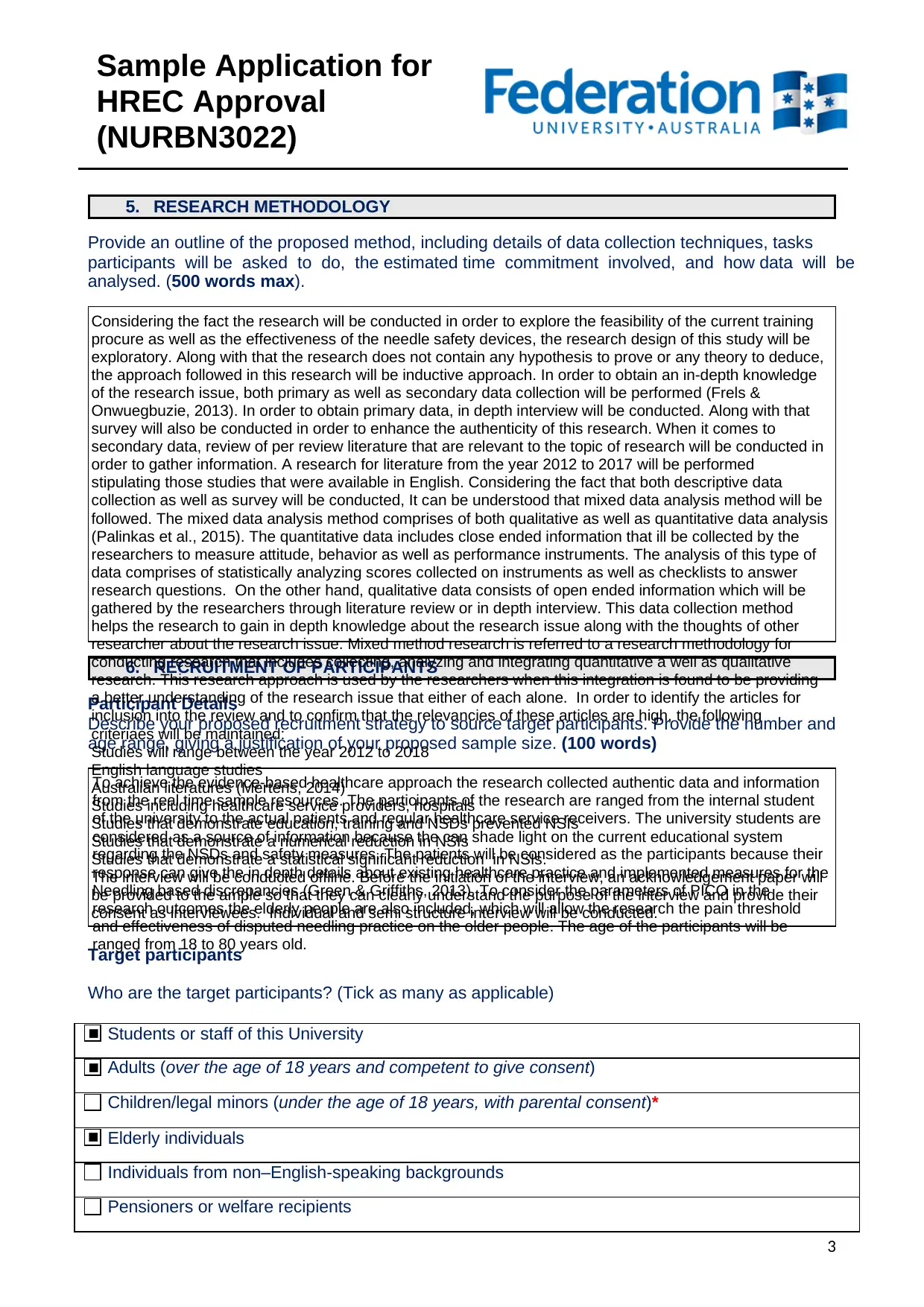
Sample Application for
HREC Approval
(NURBN3022)
5. RESEARCH METHODOLOGY
Provide an outline of the proposed method, including details of data collection techniques, tasks
participants will be asked to do, the estimated time commitment involved, and how data will be
analysed. (500 words max).
6. RECRUITMENT OF PARTICIPANTS
Participant Details
Describe your proposed recruitment strategy to source target participants. Provide the number and
age range, giving a justification of your proposed sample size. (100 words)
Target participants
Who are the target participants? (Tick as many as applicable)
Students or staff of this University
Adults (over the age of 18 years and competent to give consent)
Children/legal minors (under the age of 18 years, with parental consent)*
Elderly individuals
Individuals from non–English-speaking backgrounds
Pensioners or welfare recipients
3
Considering the fact the research will be conducted in order to explore the feasibility of the current training
procure as well as the effectiveness of the needle safety devices, the research design of this study will be
exploratory. Along with that the research does not contain any hypothesis to prove or any theory to deduce,
the approach followed in this research will be inductive approach. In order to obtain an in-depth knowledge
of the research issue, both primary as well as secondary data collection will be performed (Frels &
Onwuegbuzie, 2013). In order to obtain primary data, in depth interview will be conducted. Along with that
survey will also be conducted in order to enhance the authenticity of this research. When it comes to
secondary data, review of per review literature that are relevant to the topic of research will be conducted in
order to gather information. A research for literature from the year 2012 to 2017 will be performed
stipulating those studies that were available in English. Considering the fact that both descriptive data
collection as well as survey will be conducted, It can be understood that mixed data analysis method will be
followed. The mixed data analysis method comprises of both qualitative as well as quantitative data analysis
(Palinkas et al., 2015). The quantitative data includes close ended information that ill be collected by the
researchers to measure attitude, behavior as well as performance instruments. The analysis of this type of
data comprises of statistically analyzing scores collected on instruments as well as checklists to answer
research questions. On the other hand, qualitative data consists of open ended information which will be
gathered by the researchers through literature review or in depth interview. This data collection method
helps the research to gain in depth knowledge about the research issue along with the thoughts of other
researcher about the research issue. Mixed method research is referred to a research methodology for
conducting research that includes collecting, analyzing and integrating quantitative a well as qualitative
research. This research approach is used by the researchers when this integration is found to be providing
a better understanding of the research issue that either of each alone. In order to identify the articles for
inclusion into the review and to confirm that the relevancies of these articles are high, the following
criteriaes will be maintained:
Studies will range between the year 2012 to 2018
English language studies
Australian literatures (Mertens, 2014)
Studies including healthcare service providers, hospitals
Studies that demonstrate education, training and NSDs prevented NSIs
Studies that demonstrate a numerical reduction in NSIs
Studies that demonstrate a statistical significant reduction in NSIs.
The interview will be conducted offline. Before the initiation of the interview, an acknowledgement paper will
be provided to the ample so that they can clearly understand the purpose of the interview and provide their
consent as interviewees. Individual and semi structure interview will be conducted.
To achieve the evidence-based healthcare approach the research collected authentic data and information
from the real time sample resources. The participants of the research are ranged from the internal student
of the university to the actual patients and regular healthcare service receivers. The university students are
considered as a source of information because the can shade light on the current educational system
regarding the NSDs and safety measures. The patients will be considered as the participants because their
response can give the in depth details about existing healthcare practice and implemented measures for the
Needling based discrepancies (Green & Griffiths, 2013). To consider the parameters of PICO in the
research outcomes the elderly people are also included, which will allow the research the pain threshold
and effectiveness of disputed needling practice on the older people. The age of the participants will be
ranged from 18 to 80 years old.
■
■
■
HREC Approval
(NURBN3022)
5. RESEARCH METHODOLOGY
Provide an outline of the proposed method, including details of data collection techniques, tasks
participants will be asked to do, the estimated time commitment involved, and how data will be
analysed. (500 words max).
6. RECRUITMENT OF PARTICIPANTS
Participant Details
Describe your proposed recruitment strategy to source target participants. Provide the number and
age range, giving a justification of your proposed sample size. (100 words)
Target participants
Who are the target participants? (Tick as many as applicable)
Students or staff of this University
Adults (over the age of 18 years and competent to give consent)
Children/legal minors (under the age of 18 years, with parental consent)*
Elderly individuals
Individuals from non–English-speaking backgrounds
Pensioners or welfare recipients
3
Considering the fact the research will be conducted in order to explore the feasibility of the current training
procure as well as the effectiveness of the needle safety devices, the research design of this study will be
exploratory. Along with that the research does not contain any hypothesis to prove or any theory to deduce,
the approach followed in this research will be inductive approach. In order to obtain an in-depth knowledge
of the research issue, both primary as well as secondary data collection will be performed (Frels &
Onwuegbuzie, 2013). In order to obtain primary data, in depth interview will be conducted. Along with that
survey will also be conducted in order to enhance the authenticity of this research. When it comes to
secondary data, review of per review literature that are relevant to the topic of research will be conducted in
order to gather information. A research for literature from the year 2012 to 2017 will be performed
stipulating those studies that were available in English. Considering the fact that both descriptive data
collection as well as survey will be conducted, It can be understood that mixed data analysis method will be
followed. The mixed data analysis method comprises of both qualitative as well as quantitative data analysis
(Palinkas et al., 2015). The quantitative data includes close ended information that ill be collected by the
researchers to measure attitude, behavior as well as performance instruments. The analysis of this type of
data comprises of statistically analyzing scores collected on instruments as well as checklists to answer
research questions. On the other hand, qualitative data consists of open ended information which will be
gathered by the researchers through literature review or in depth interview. This data collection method
helps the research to gain in depth knowledge about the research issue along with the thoughts of other
researcher about the research issue. Mixed method research is referred to a research methodology for
conducting research that includes collecting, analyzing and integrating quantitative a well as qualitative
research. This research approach is used by the researchers when this integration is found to be providing
a better understanding of the research issue that either of each alone. In order to identify the articles for
inclusion into the review and to confirm that the relevancies of these articles are high, the following
criteriaes will be maintained:
Studies will range between the year 2012 to 2018
English language studies
Australian literatures (Mertens, 2014)
Studies including healthcare service providers, hospitals
Studies that demonstrate education, training and NSDs prevented NSIs
Studies that demonstrate a numerical reduction in NSIs
Studies that demonstrate a statistical significant reduction in NSIs.
The interview will be conducted offline. Before the initiation of the interview, an acknowledgement paper will
be provided to the ample so that they can clearly understand the purpose of the interview and provide their
consent as interviewees. Individual and semi structure interview will be conducted.
To achieve the evidence-based healthcare approach the research collected authentic data and information
from the real time sample resources. The participants of the research are ranged from the internal student
of the university to the actual patients and regular healthcare service receivers. The university students are
considered as a source of information because the can shade light on the current educational system
regarding the NSDs and safety measures. The patients will be considered as the participants because their
response can give the in depth details about existing healthcare practice and implemented measures for the
Needling based discrepancies (Green & Griffiths, 2013). To consider the parameters of PICO in the
research outcomes the elderly people are also included, which will allow the research the pain threshold
and effectiveness of disputed needling practice on the older people. The age of the participants will be
ranged from 18 to 80 years old.
■
■
■
⊘ This is a preview!⊘
Do you want full access?
Subscribe today to unlock all pages.

Trusted by 1+ million students worldwide
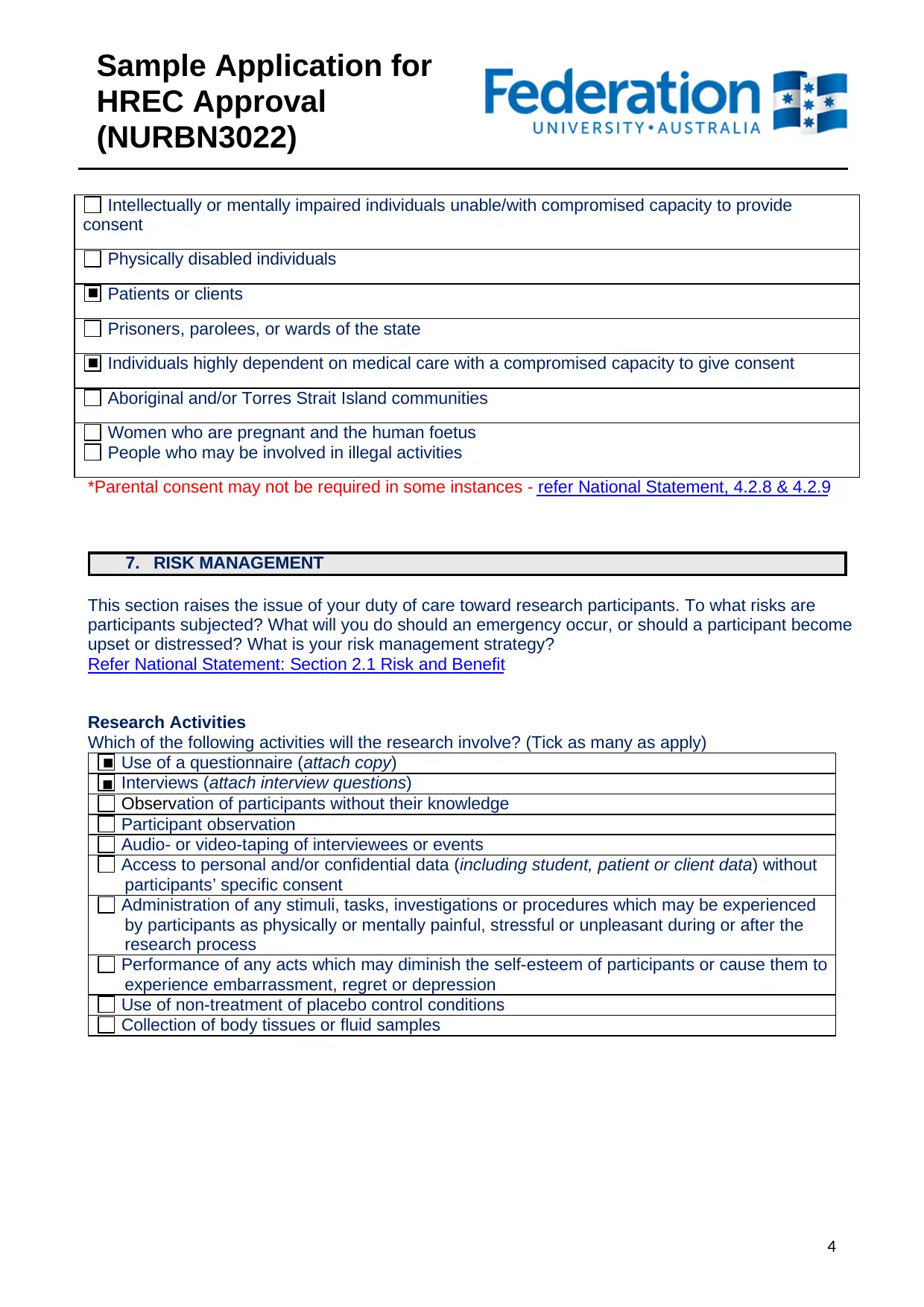
Sample Application for
HREC Approval
(NURBN3022)
Intellectually or mentally impaired individuals unable/with compromised capacity to provide
consent
Physically disabled individuals
Patients or clients
Prisoners, parolees, or wards of the state
Individuals highly dependent on medical care with a compromised capacity to give consent
Aboriginal and/or Torres Strait Island communities
Women who are pregnant and the human foetus
People who may be involved in illegal activities
*Parental consent may not be required in some instances - refer National Statement, 4.2.8 & 4.2.9
7. RISK MANAGEMENT
This section raises the issue of your duty of care toward research participants. To what risks are
participants subjected? What will you do should an emergency occur, or should a participant become
upset or distressed? What is your risk management strategy?
Refer National Statement: Section 2.1 Risk and Benefit
Research Activities
Which of the following activities will the research involve? (Tick as many as apply)
Use of a questionnaire (attach copy)
Interviews (attach interview questions)
Observation of participants without their knowledge
Participant observation
Audio- or video-taping of interviewees or events
Access to personal and/or confidential data (including student, patient or client data) without
participants’ specific consent
Administration of any stimuli, tasks, investigations or procedures which may be experienced
by participants as physically or mentally painful, stressful or unpleasant during or after the
research process
Performance of any acts which may diminish the self-esteem of participants or cause them to
experience embarrassment, regret or depression
Use of non-treatment of placebo control conditions
Collection of body tissues or fluid samples
4
■
■
■
■
HREC Approval
(NURBN3022)
Intellectually or mentally impaired individuals unable/with compromised capacity to provide
consent
Physically disabled individuals
Patients or clients
Prisoners, parolees, or wards of the state
Individuals highly dependent on medical care with a compromised capacity to give consent
Aboriginal and/or Torres Strait Island communities
Women who are pregnant and the human foetus
People who may be involved in illegal activities
*Parental consent may not be required in some instances - refer National Statement, 4.2.8 & 4.2.9
7. RISK MANAGEMENT
This section raises the issue of your duty of care toward research participants. To what risks are
participants subjected? What will you do should an emergency occur, or should a participant become
upset or distressed? What is your risk management strategy?
Refer National Statement: Section 2.1 Risk and Benefit
Research Activities
Which of the following activities will the research involve? (Tick as many as apply)
Use of a questionnaire (attach copy)
Interviews (attach interview questions)
Observation of participants without their knowledge
Participant observation
Audio- or video-taping of interviewees or events
Access to personal and/or confidential data (including student, patient or client data) without
participants’ specific consent
Administration of any stimuli, tasks, investigations or procedures which may be experienced
by participants as physically or mentally painful, stressful or unpleasant during or after the
research process
Performance of any acts which may diminish the self-esteem of participants or cause them to
experience embarrassment, regret or depression
Use of non-treatment of placebo control conditions
Collection of body tissues or fluid samples
4
■
■
■
■
Paraphrase This Document
Need a fresh take? Get an instant paraphrase of this document with our AI Paraphraser
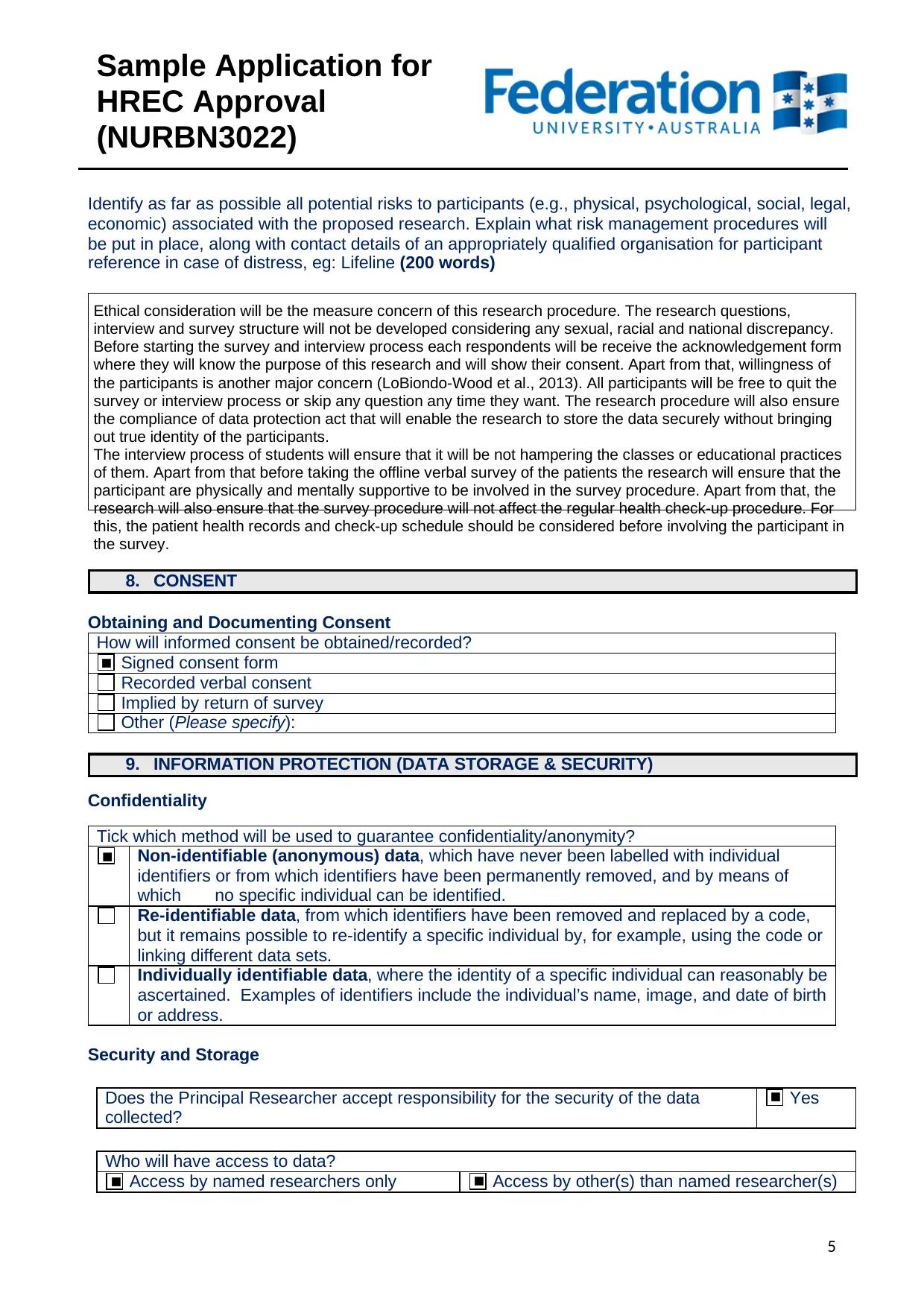
Sample Application for
HREC Approval
(NURBN3022)
Identify as far as possible all potential risks to participants (e.g., physical, psychological, social, legal,
economic) associated with the proposed research. Explain what risk management procedures will
be put in place, along with contact details of an appropriately qualified organisation for participant
reference in case of distress, eg: Lifeline (200 words)
8. CONSENT
Obtaining and Documenting Consent
How will informed consent be obtained/recorded?
Signed consent form
Recorded verbal consent
Implied by return of survey
Other (Please specify):
9. INFORMATION PROTECTION (DATA STORAGE & SECURITY)
Confidentiality
Tick which method will be used to guarantee confidentiality/anonymity?
Non-identifiable (anonymous) data, which have never been labelled with individual
identifiers or from which identifiers have been permanently removed, and by means of
which no specific individual can be identified.
Re-identifiable data, from which identifiers have been removed and replaced by a code,
but it remains possible to re-identify a specific individual by, for example, using the code or
linking different data sets.
Individually identifiable data, where the identity of a specific individual can reasonably be
ascertained. Examples of identifiers include the individual’s name, image, and date of birth
or address.
Security and Storage
Does the Principal Researcher accept responsibility for the security of the data
collected?
Yes
Who will have access to data?
Access by named researchers only Access by other(s) than named researcher(s)
5
Ethical consideration will be the measure concern of this research procedure. The research questions,
interview and survey structure will not be developed considering any sexual, racial and national discrepancy.
Before starting the survey and interview process each respondents will be receive the acknowledgement form
where they will know the purpose of this research and will show their consent. Apart from that, willingness of
the participants is another major concern (LoBiondo-Wood et al., 2013). All participants will be free to quit the
survey or interview process or skip any question any time they want. The research procedure will also ensure
the compliance of data protection act that will enable the research to store the data securely without bringing
out true identity of the participants.
The interview process of students will ensure that it will be not hampering the classes or educational practices
of them. Apart from that before taking the offline verbal survey of the patients the research will ensure that the
participant are physically and mentally supportive to be involved in the survey procedure. Apart from that, the
research will also ensure that the survey procedure will not affect the regular health check-up procedure. For
this, the patient health records and check-up schedule should be considered before involving the participant in
the survey.
■
■
■
■ ■
HREC Approval
(NURBN3022)
Identify as far as possible all potential risks to participants (e.g., physical, psychological, social, legal,
economic) associated with the proposed research. Explain what risk management procedures will
be put in place, along with contact details of an appropriately qualified organisation for participant
reference in case of distress, eg: Lifeline (200 words)
8. CONSENT
Obtaining and Documenting Consent
How will informed consent be obtained/recorded?
Signed consent form
Recorded verbal consent
Implied by return of survey
Other (Please specify):
9. INFORMATION PROTECTION (DATA STORAGE & SECURITY)
Confidentiality
Tick which method will be used to guarantee confidentiality/anonymity?
Non-identifiable (anonymous) data, which have never been labelled with individual
identifiers or from which identifiers have been permanently removed, and by means of
which no specific individual can be identified.
Re-identifiable data, from which identifiers have been removed and replaced by a code,
but it remains possible to re-identify a specific individual by, for example, using the code or
linking different data sets.
Individually identifiable data, where the identity of a specific individual can reasonably be
ascertained. Examples of identifiers include the individual’s name, image, and date of birth
or address.
Security and Storage
Does the Principal Researcher accept responsibility for the security of the data
collected?
Yes
Who will have access to data?
Access by named researchers only Access by other(s) than named researcher(s)
5
Ethical consideration will be the measure concern of this research procedure. The research questions,
interview and survey structure will not be developed considering any sexual, racial and national discrepancy.
Before starting the survey and interview process each respondents will be receive the acknowledgement form
where they will know the purpose of this research and will show their consent. Apart from that, willingness of
the participants is another major concern (LoBiondo-Wood et al., 2013). All participants will be free to quit the
survey or interview process or skip any question any time they want. The research procedure will also ensure
the compliance of data protection act that will enable the research to store the data securely without bringing
out true identity of the participants.
The interview process of students will ensure that it will be not hampering the classes or educational practices
of them. Apart from that before taking the offline verbal survey of the patients the research will ensure that the
participant are physically and mentally supportive to be involved in the survey procedure. Apart from that, the
research will also ensure that the survey procedure will not affect the regular health check-up procedure. For
this, the patient health records and check-up schedule should be considered before involving the participant in
the survey.
■
■
■
■ ■
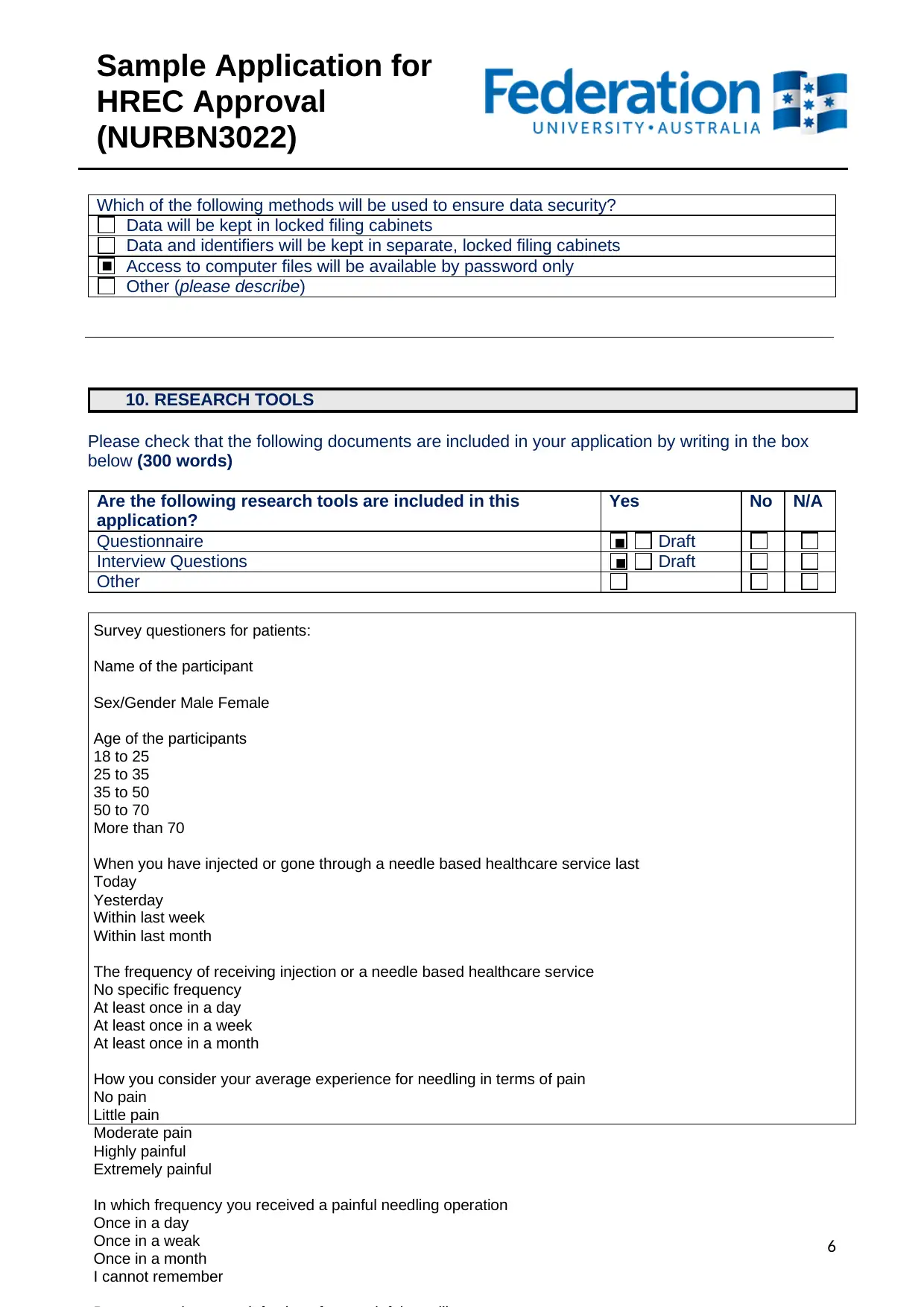
Sample Application for
HREC Approval
(NURBN3022)
Which of the following methods will be used to ensure data security?
Data will be kept in locked filing cabinets
Data and identifiers will be kept in separate, locked filing cabinets
Access to computer files will be available by password only
Other (please describe)
10. RESEARCH TOOLS
Please check that the following documents are included in your application by writing in the box
below (300 words)
Are the following research tools are included in this
application?
Yes No N/A
Questionnaire Draft
Interview Questions Draft
Other
6
■
■
■
Survey questioners for patients:
Name of the participant
Sex/Gender Male Female
Age of the participants
18 to 25
25 to 35
35 to 50
50 to 70
More than 70
When you have injected or gone through a needle based healthcare service last
Today
Yesterday
Within last week
Within last month
The frequency of receiving injection or a needle based healthcare service
No specific frequency
At least once in a day
At least once in a week
At least once in a month
How you consider your average experience for needling in terms of pain
No pain
Little pain
Moderate pain
Highly painful
Extremely painful
In which frequency you received a painful needling operation
Once in a day
Once in a weak
Once in a month
I cannot remember
HREC Approval
(NURBN3022)
Which of the following methods will be used to ensure data security?
Data will be kept in locked filing cabinets
Data and identifiers will be kept in separate, locked filing cabinets
Access to computer files will be available by password only
Other (please describe)
10. RESEARCH TOOLS
Please check that the following documents are included in your application by writing in the box
below (300 words)
Are the following research tools are included in this
application?
Yes No N/A
Questionnaire Draft
Interview Questions Draft
Other
6
■
■
■
Survey questioners for patients:
Name of the participant
Sex/Gender Male Female
Age of the participants
18 to 25
25 to 35
35 to 50
50 to 70
More than 70
When you have injected or gone through a needle based healthcare service last
Today
Yesterday
Within last week
Within last month
The frequency of receiving injection or a needle based healthcare service
No specific frequency
At least once in a day
At least once in a week
At least once in a month
How you consider your average experience for needling in terms of pain
No pain
Little pain
Moderate pain
Highly painful
Extremely painful
In which frequency you received a painful needling operation
Once in a day
Once in a weak
Once in a month
I cannot remember
⊘ This is a preview!⊘
Do you want full access?
Subscribe today to unlock all pages.

Trusted by 1+ million students worldwide
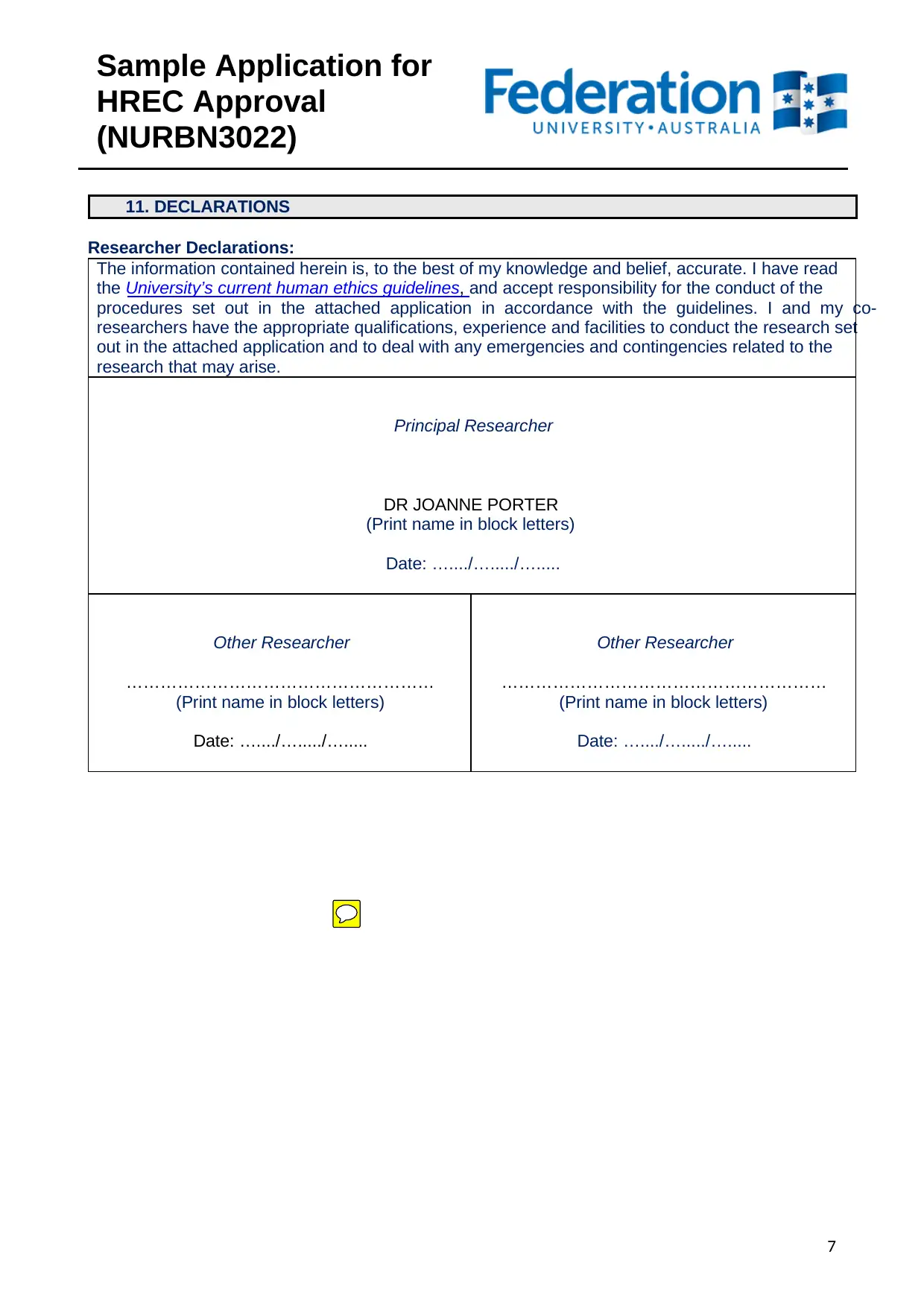
Sample Application for
HREC Approval
(NURBN3022)
11. DECLARATIONS
Researcher Declarations:
The information contained herein is, to the best of my knowledge and belief, accurate. I have read
the University’s current human ethics guidelines, and accept responsibility for the conduct of the
procedures set out in the attached application in accordance with the guidelines. I and my co-
researchers have the appropriate qualifications, experience and facilities to conduct the research set
out in the attached application and to deal with any emergencies and contingencies related to the
research that may arise.
Principal Researcher
DR JOANNE PORTER
(Print name in block letters)
Date: …..../…...../….....
Other Researcher
………………………………………………
(Print name in block letters)
Date: …..../…...../….....
Other Researcher
…………………………………………………
(Print name in block letters)
Date: …..../…...../….....
7
HREC Approval
(NURBN3022)
11. DECLARATIONS
Researcher Declarations:
The information contained herein is, to the best of my knowledge and belief, accurate. I have read
the University’s current human ethics guidelines, and accept responsibility for the conduct of the
procedures set out in the attached application in accordance with the guidelines. I and my co-
researchers have the appropriate qualifications, experience and facilities to conduct the research set
out in the attached application and to deal with any emergencies and contingencies related to the
research that may arise.
Principal Researcher
DR JOANNE PORTER
(Print name in block letters)
Date: …..../…...../….....
Other Researcher
………………………………………………
(Print name in block letters)
Date: …..../…...../….....
Other Researcher
…………………………………………………
(Print name in block letters)
Date: …..../…...../….....
7
1 out of 7
Related Documents
Your All-in-One AI-Powered Toolkit for Academic Success.
+13062052269
info@desklib.com
Available 24*7 on WhatsApp / Email
![[object Object]](/_next/static/media/star-bottom.7253800d.svg)
Unlock your academic potential
Copyright © 2020–2025 A2Z Services. All Rights Reserved. Developed and managed by ZUCOL.





